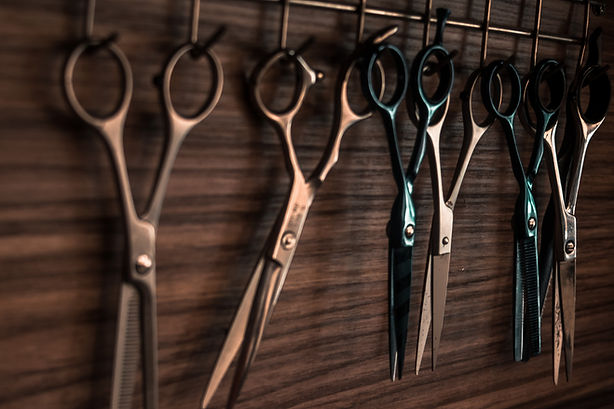
Scissor Maintenance
Understanding Scissors #1:
Maintenance & Why This Should Be In Your Daily Routine
Every stylist owns at least one pair of scissors, so it makes sense to get the most from yours by understanding them, knowing what to look for when buying them, and how to maintain them. This series will give you this information. Firstly, we look at the steps we can all take to show our scissors some TLC
We asked Spencer Dudman, from Spencer Scissors, a well-regarded industry expert, for
his top tips for getting the most out of this essential piece of every stylist’s kit.
Buy proper scissor oil and use this every day on your scissors.
This is tremendously important for the longevity and performance of your scissors, and is
an inexpensive must-have. It protects your scissors from corrosion and rust, and ensures
the smooth running of the central mechanism.
Scissor oil works differently to the machine oil often used with clippers – if this is used on scissors, it acts to drive hair etc. into the centre screw instead of away from it, clogging up and eventually damaging the mechanism that should keep the cutting action effortless.
Tensioning
Scissors are precisely crafted instruments, and this is how they should be treated. The correct tension is vitally important, yet many stylists have been taught to think that it this is a matter of personal preference, and often run their scissors too loose. This is bad for scissors, the stylist and the client’s hair.
Check the tension of your scissors throughout the day, by following these simple steps:
Hold the scissor vertically by the thumb loop and lift the finger
loop to a horizontal position
Let go of the finger loop and jiggle slightly
The finger handle should only fall a small way
Falling even halfway means the tension is too loose – this will damage the cutting
edge of the scissors by forcing the stylist to apply pressure to bring the blades together
(pressure cutting)
Adjust the tension if necessary, and repeat the above steps until perfect tension is
achieved.
Cleaning
It goes without saying that scissors should be cleaned after every haircut - wet hair and products are not good for scissors and can lead to the life expectancy of your scissors being cut short by corrosion.
Rust and other forms of corrosion literally eat into your scissors, and this is irreversible. A good service will take the blade edge back to the remaining undamaged metal, but if the corrosion is extensive, this may
mean that the length is reduced.
Prevention is definitely better than cure!
Chamois leather or alternative
Use an old piece for wiping blades clean of hair etc.
Doubling or tripling the piece of cloth, fold over the cutting edge of the blade and with some downward pressure very carefully wipe along the length of each blade in turn. Please be very careful not to place your hand or fingers over the cutting edge, even with the cloth as nasty cuts can happen.
This is really worthwhile to do as often as you can – ideally after every haircut, as this helps to keep the scissors sharper for longer by pushing any burrs created by cutting (and especially pressure cutting) away from the edge.
The importance of a regular, thorough service cannot be over emphasised.
I am often asked whether there’s a difference between sharpening and servicing. The truth is there is a massive difference: as a master bladesmith, the professional service I offer is a complete re-manufacturing, and sharpening is just one of the seven key stages done to return your scissors to the way they felt when new - and often better than new, if they were out of sett to start with!
How often you get your scissors serviced depends on the amount of haircuts you do, whether you pressure-cut, the metal and the manner of manufacture. A good grade steel will hold an edge for longer, and drop forged scissors will last longer than cast ones.
Regular servicing can stop potential long-term damage to scissors by highlighting problems, for example lack of oil leading to the start of corrosion, and correct them with the very minimal amount of metal being taken off.
Scissors that have been dropped should be serviced right away. Dropping (or throwing scissors down on a counter etc.) frequently causes nicks along the blade, which if left untreated cause further damage to the blade and serious damage to your clients’ hair, which in turn could hurt your bottom- line as nicks catch and pull hair, making for an unpleasant cutting experience.
Even if the scissors have escaped obvious metal damage, very often stylists notice that they do not feel the same, and their cutting becomes more laboured. This is caused by the scissors no longer being in sett. During every service, the sett is checked, and corrected as necessary.
All of the above are essential to maintain scissors at their best, and save money as well: sharp scissors enable quicker cutting with greater accuracy, and reduce the risk of Repetitive Strain Injuries (RSI).
Your relationship with your scissors is like any other relationship: if you are well suited and time and effort is put into maintaining them they should last the distance…
For further information and a demonstration, please see my scissor maintenance video on YouTube, under Spencer Scissors, and for further information please contact me via www.spencerscissors.co.uk or call 07817 082754.
If you have any questions, please get in touch – always happy to help talented barbers show their scissors some love!







